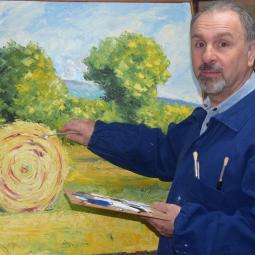Biography
ARTISTIC EDUCATION
He has been student of the teacher Stenio Petroni for two years, he has attended the “Libera accademia di Belle Arti, fondazione Trossi-Uberti” in Leghorn for five years and graduated there in 1996. He has also attended the course of the School of Nude Figure Drawing at “Accademia di Belle Arti” in Florence.
PAINTER-DRAWER-ENGRAVER. QUOTED.
TECHNIQUES
Oil painting on canvas, oil painting on panel, acrylic on paper, charcoal, the bloodding-pencil etc.… .
SUBJECTS: landscapes, still lives, flowers, animals and figures.
CRITIQUE
He has been mentioned in manies specialized magazines like "Il Quadrato", "Elite Selezione Arte Italiana", "Top Art", "Comanducci", "Dizionario Enciclopedico d'Arte Contemporanea", "Pittori della Toscana", "Pittori di fama Europea", "Arte Moderna" etc…
His works are displayed both in public and private art galleries, in different collections, in Bandera Palace’s historical archive, at Museum of Busto Arsizio, at Museum of Castagneto Carducci and in different Tuscan municipalities. He is also mentioned in great part of prestigious yearbooks and catalogues of Modern art and lots of recognized and remarkable critics of art and specialist journalists have written about him.
“…A complete artist, able to make every touching situation vibrate within his paintings, situation suggested by the nature, landscape or still-life…”
(F. Minervai, critic of art)
“…A complete painter who favours the nature watching her with the eyes of a child through which he manages to catch her essence, her scent, her poetry, her lyrical side which then he transposes on canvas. By admiring his works you can certainly find out the dimension of a poetic soul that composes a singing with colours…”
(prof. Hans Schmid).
“… Stefano Bianchi is a painter who was born in Piombino and currently lives in San Vincenzo with a solid academic education. For more than twenty years he has carried out an intense exhibition activity that has enabled him to achieve lots of national recognitions. Although he has concentrated on human figure with great results - above any other on subjects of sacred character – he clearly favours landscape and still lives. His flowers arouse emotions with their specific chromaticism halfway between reality and symbolism, by the choice of a larger and more concise brushstroke than the usual “impressionistic” technique. In his landscapes we can easily infer, beyond his sense of observation, his interest for everything that stand for an important element of our land’s historical memory, even if in the shape of ruins. For example I can allude to Campiglia Marittima’s “Etruscan mines“ which he is evocatively able to return them to their architectural splendour on painting without appearing to contradict their current state of picturesque ruins…”
(prof. Pablo Gorini)






